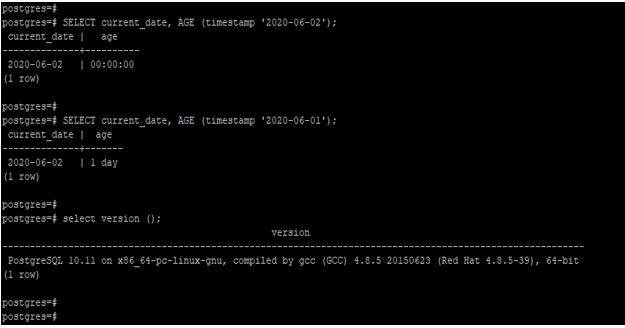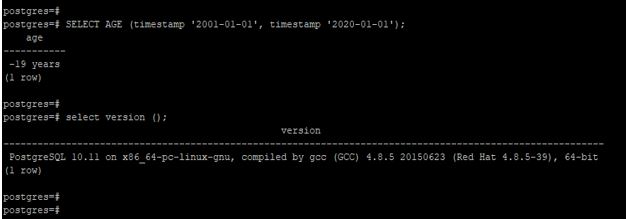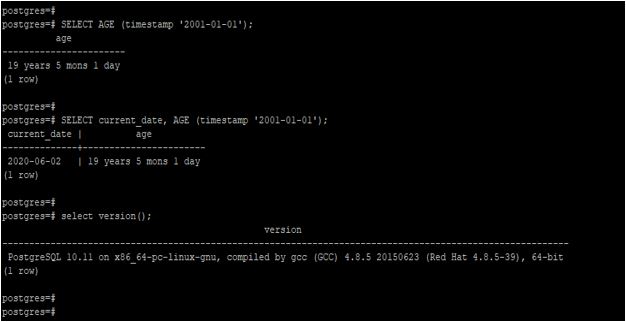Updated May 19, 2023

Introduction to PostgreSQL age() Function
PostgreSQL age() function is used to calculate the age between two dates, it will return the number of years, days, and months between the two different dates. Age function in PostgreSQL will accept the two arguments as date timestamp and return the calculated difference between two different dates. The age function in PostgreSQL is to perform the two different calculations depending on which parameter we have used with the age function. Age function is very important and useful in PostgreSQL to subtract the arguments and produce the symbolic result used in months and years.
Syntax
Below is the syntax of age function:
age (timestamp, timestamp)OR
age(date1, date2)OR
age (timestamp)Parameters
Below is the parameter description syntax of age function in PostgreSQL:
Age: This is a function in PostgreSQL used to return the interval type. The age function basically accepts the two-parameter to return the result. Age function in PostgreSQL will accept the timestamp value as its input parameter.
Timestamp: In PostgreSQL, the age function accepts timestamp arguments. When using the age function, two timestamps are specified as arguments, and the second argument is subtracted from the first argument.
Date 1 and Date 2: This is the same as the timestamp which we have used with age function in PostgreSQL. It will work the same as the timestamp work in the age function. We can use the first date as the current date.
How does PostgreSQL age() function works?
Below is the working of age function in PostgreSQL:
We are using the age function in PostgreSQL to return the year, month, and day as a result from two timestamps. For using the age function in PostgreSQL, we need to pass two arguments. The first argument as a timestamp or current date, and the second argument is a timestamp. We also use the current date as the first timestamp in the first argument. The below example shows that we are using the current date as the first argument with the age function in PostgreSQL. If we want to return the current age of the person, then we are using the current date as the first argument with the age function.
Code:
SELECT current_date, AGE (timestamp ‘2001-10-10’);Output:
Explanation: In the above example, we have considered the age of the person as 10-10-2001. Also, we have subtracted this age from the current date. After subtracting the person’s age are 18 years, 7 months, and 23 days. The age function uses the current system time to calculate the age. If we need to calculate an age for different times, then we need to pass two-argument with the age function. PostgreSQL age function will perform the two different calculations, it depends on which parameter we have passed with the age function. We are providing two date timestamps, and we have also provided a current timestamp in the first parameter.
Age function in PostgreSQL will return the result in the following format are as follows:
XXXX(Year): xx(Month) -xx (Day): It is defined as the first result being the year, the second result is the month, and the third result is the day.
xx (Month): xx (Day): It is defined as the first result is the month, and the second result is the day.
xx (Day): It will return only days as a result of using the age function.
The return type of age function in PostgreSQL is an interval. Age function in PostgreSQL is used in PostgreSQL versions of 8.4 to 12. We using age function in business applications where we have calculated the age of persons, the year of service of the employee, and where we have to calculate the number of years, month, and days. The age function is commonly utilized in web applications for calculating the age of students or employees. Age function calculates the result from the midnight of the day. It will update the next day from midnight. Suppose we need tp calculate the difference between the current date and yesterday’s date using age function. It will update the age from midnight (12:00 clock). Age function will calculate the day in a 24-hour format.
Below example shows that the age function will return the result from the midnight as 12:00 clock:
Code:
SELECT current_date, AGE (timestamp '2020-06-02');
SELECT current_date, AGE (timestamp '2020-06-01');Output:
Explanation: In the above example, we have used today’s date with the current date function then, the age function will return the result as zero days. In the second example, we have used yesterday’s date after using yesterday’s date with the current date, it will return the result as one day.
Examples
Below are the examples mentioned:
Example #1. Use two timestamp value with the age function
In the below example, we have passed two date values with the age function. In the first timestamp, we have the passing timestamp value as “2020-01-01,” and in the second timestamp, we have the passing timestamp value as “2001-01-01”.
Code:
SELECT AGE (timestamp '2020-01-01', timestamp '2001-01-01');Output:
Example #2. Use two timestamp value with the age function
(Use first date is less than the second date)
In the example below, we pass two date values with the age function. In the first timestamp, we have the passing timestamp value as “2001-01-01,” and in the second timestamp, we have the passing timestamp value as “2020-01-01”.
Code:
SELECT AGE (timestamp '2001-01-01', timestamp '2020-01-01');Output:
Example #3. Use two current date value with the age function
In the example below, we have used the current date in the first parameter and the second parameter data as “2001-01-01”.
Code:
two current date
SELECT AGE (timestamp '2001-01-01');
SELECT current_date, AGE (timestamp '2001-01-01');Output:
Recommended Articles
We hope that this EDUCBA information on “PostgreSQL age()” was beneficial to you. You can view EDUCBA’s recommended articles for more information.





